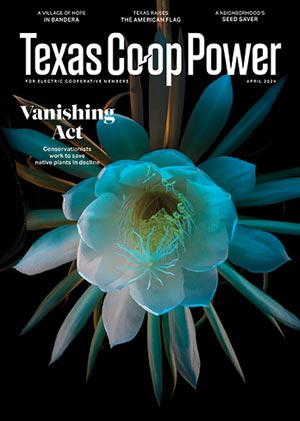Come mid-May, I turn into a street walker. Not that kind, mind you. Instead, I ply my trade with a green plastic cup and sharp eyes.
“Oh, there you are,” hollers James, my husband, who’s strolling along Greenlawn Parkway. “I figured I’d find you over here!”
My gaze is fastened on clumps of lazy daisies growing along the street. Among the white-petaled blooms with orange centers, I scan for dried seed heads. Now and then, I spot one. Happily, I lean down, pinch it off, then drop the itsy-bitsy treasure into my cup.
We walk while I scope out wildflowers that grow along a ditch. Patiently, I’m watching for Texas prairie parsleys, winecups and beeblossoms going to seed. I’ll collect some seeds—but not all. I want to admire them again next spring.
I also want to establish them in our yard.
Since 2008, we’ve nurtured Texas native plant gardens at our Blanco home and adjoining meadow, a former vacant lot. Since then, I’ve expanded into rescuing, preserving and protecting overlooked native species that grow in our neighborhood. I collect seeds whenever I can.
Sometimes I dig up and relocate plants, too. For instance, a next-door neighbor several years ago gave me permission to transplant a yellow passionflower, Texas lespedeza and hoary false goldenaster that grew on her side of the fence, where they were often mowed down. Now the trio grows, unrestrained and lush, in our backyard.
I’ve also relocated Indian mallow, Texas snoutbean, scarlet pea, narrowleaf blue-eyed grass and Texas frogfruit to our gardens. Roemer’s mimosa, too. I love to show kids how their tiny leaves fold up when touched. Magic!
Two regular walkers once rang our doorbell. “What’s this?” asked Yalene, while daughter Arden held up a slender branch with yellow flowers. I eyeballed the specimen. Lindheimer’s senna? James and I beelined to the easement where they’d found the plant. It was twoleaf senna, a new-to-me species. A few weeks later, I collected seeds from the site, which has since been cleared. Hopefully the seeds will germinate in our meadow, and the twoleaf senna will live on.
Why go to all that trouble? Because I deeply care about these plants. Because they were here long before us. Because they’re resilient and adapted to our soils and climate. Because they, unlike most ornamental plants, sustain the pollinators and other wildlife that inhabit this place we call home.
From blunt-leaf rabbit-tobacco to zizotes milkweed, we’ve welcomed neighborhood natives into our gardens, where I hope they’ll be appreciated and perpetuated for years to come. So call me a renegade. Or call me a tree hugger. I’ll answer to either one and make no excuses.
I’m a street walker on a mission in a green-light district.



